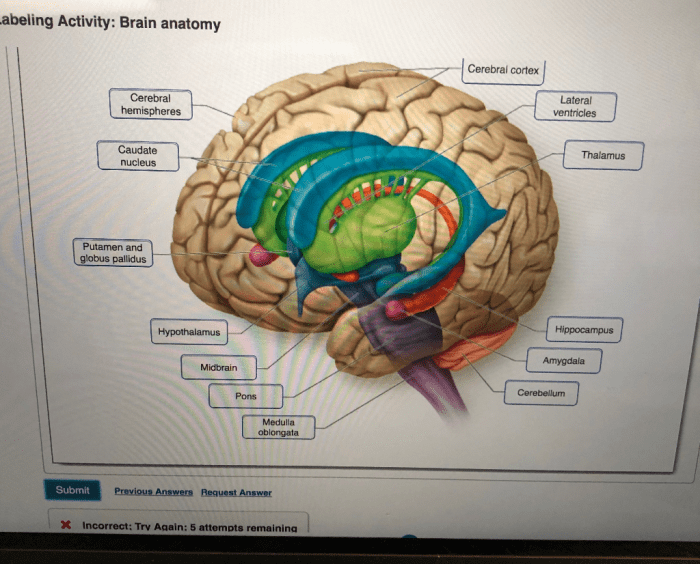Art labeling activity brain anatomy embarks on an intriguing journey, revealing the potential of art as a powerful tool in unraveling the complexities of brain anatomy. This innovative approach not only fosters a deeper understanding of the brain’s intricate structures but also stimulates creativity and engagement in the learning process.
Through the fusion of art and science, art labeling activities provide a unique and interactive way to explore the brain’s anatomy. By engaging with visual representations, learners can visualize and comprehend the intricate network of brain structures and their functions, fostering a comprehensive understanding of this vital organ.
Art Labeling Activity: Brain Anatomy
Art labeling activities offer a unique and engaging way to teach brain anatomy. By incorporating artistic elements, students can develop a deeper understanding of the brain’s structures and functions.
Benefits of Art Labeling Activities
- Enhance visual memory and recall.
- Foster creativity and imagination.
- Promote collaboration and teamwork.
- Make learning more enjoyable and interactive.
Step-by-Step Guide
- Prepare a labeled diagram of the brain.
- Provide students with blank diagrams and art supplies.
- Have students identify and label the brain structures.
- Encourage students to use different colors, shapes, and textures to represent the structures.
- Discuss the functions and connections of the labeled structures.
Art Materials
- Colored pencils
- Markers
- Crayons
- Paint
- Collage materials
Brain Anatomy Structures

Major Structures
| Structure | Function |
|---|---|
| Cerebrum | Higher-order cognitive functions, including language, memory, and problem-solving |
| Cerebellum | Coordination, balance, and motor control |
| Brainstem | Basic life functions, such as breathing, heart rate, and sleep-wake cycle |
| Hypothalamus | Regulates body temperature, hunger, thirst, and sleep |
| Pituitary gland | Produces hormones that regulate growth, metabolism, and reproduction |
Connections, Art labeling activity brain anatomy
The brain structures are interconnected by a complex network of neurons. These connections allow for the transmission of information and the coordination of brain functions.
Artistic Representation of Brain Anatomy
Historical Perspectives
Artists have depicted brain anatomy throughout history, from ancient Egyptian hieroglyphs to modern MRI scans. These representations have influenced our understanding of the brain and its functions.
Contemporary Artwork
Contemporary artists continue to explore brain anatomy in their work. Some examples include:
- The “Brain Project” by Damien Hirst
- The “Synapse” series by Jenny Saville
- The “Neurographic” sculptures by Alexander Ponomarev
Educational Applications: Art Labeling Activity Brain Anatomy

Learning Enhancement
Art labeling activities can enhance student learning by:
- Providing a hands-on and interactive experience.
- Promoting active recall and critical thinking.
- Making learning more memorable and meaningful.
Lesson Plans and Activities
- Create a labeled brain diagram with students using different art materials.
- Have students design their own brain-inspired artwork and present it to the class.
- Organize a field trip to a museum or science center to view artistic representations of the brain.
Assessment Strategies
- Observe students’ labeling accuracy and understanding of brain structures.
- Assess students’ creativity and artistic skills.
- Evaluate students’ presentations on their brain-inspired artwork.
Future Directions

Research
Future research could explore the effectiveness of art labeling activities in teaching brain anatomy and its impact on long-term retention.
Technology
New technologies, such as virtual reality and augmented reality, offer potential for immersive and interactive art labeling experiences.
Innovative Ideas
- Develop interactive online platforms for art labeling activities.
- Create augmented reality apps that allow students to explore brain anatomy in 3D.
- Collaborate with artists to design novel and engaging art labeling experiences.
FAQ
What are the benefits of using art labeling activities to teach brain anatomy?
Art labeling activities enhance visual learning, promote active engagement, and foster a deeper understanding of brain structures and their functions.
How can art labeling activities be incorporated into brain anatomy lessons?
Art labeling activities can be integrated into lessons through guided labeling exercises, collaborative art projects, and interactive quizzes.
What types of art materials are suitable for brain anatomy labeling activities?
Appropriate art materials include markers, crayons, colored pencils, paint, and modeling clay, allowing learners to express their creativity while exploring brain anatomy.